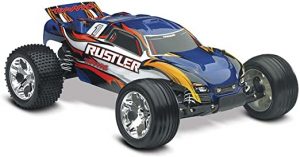Table of Contents
Introduction
RC cars are also called Radio-controlled or Remote-controlled cars. They are self-propelled model cars or trucks that are controlled from a distance with a specialized transmitter or remote. Remote-controlled and radio-controlled usually refer to the same thing but are also slightly different in that a wire connects the remote-controlled car to its controller while radio-controlled cars use radio frequency link to control the vehicle. However, RC cars usually refer to the radio-frequency car because the remote-controlled is outdated.
RC cars can be classified into two based on their power source; they can either be electric or gas-powered. The electric RC cars work with an electric motor and rechargeable cells. The electric motor can either be brushless or brushed. The brushless is known to be powerful and more expensive. The gas-powered RC cars use internal combustion engines that are powered by a mixture of methanol and oil. There are bigger models of the gas-powered that use small gasoline engines and require a mix of gas and oil.
How RC Cars Work?
RC cars work with certain components that are in constant communication to keep the car in motion. They use a remote control that has joysticks and wheels used to control the vehicle. When the remote control is pressed, it sends radio signals to the receiver, which is situated in the car. The receiver changes the radio signal into an electrical signal that is more suitable for the components of the car. Once the receiver receives the signal, it activates the circuit and sends signals to it. The circuit interprets the signals and directs the commands to each part of the car. The components of the RC car is powered by the power source which may be electric or gas, as previously stated. This allows the car to perform actions like steering, braking and forward or reverse motions. The remote control or transmitter that sends radio signals to the receiver uses a 9-volt battery.
To know more about RC cars, see
Components Of An RC Car
It is important to understand the function of each component of the RC car to get full knowledge of how it works. RC cars have four main parts that control the car; these parts are the power source, the motor, the transmitter and the receiver.
Power Source
The power source is the most important component of the RC car. This is what powers the car and allows it to run. RC cars can’t function properly without a good power source; the power source could be an electrical source like a rechargeable battery or a gas-powered engine. The electric models are more expensive and require a high level of skill.
Motor
The motor is the powerhouse of the car. The motor allows you to move and control the car. It does most of the work and enables the car to perform many functions. Most sophisticated RC cars have more complex motors, and they require more than one motor to perform functions other than moving and turning.
Transmitter
The transmitter is the component that controls the car. This is also known as the remote control. It has joysticks for control, a trigger that controls the throttle and wheels for turning the vehicle. It works by sending radio waves to the receiver which is in the car. It is powered by batteries, usually a 9-volt battery and it uses keys or controls to send waves or information to the car.
Receiver
The receiver is located in the car and is in the form of an antenna and a circuit. They both receive the radio waves sent by the transmitter and control the car. The antenna receives the radio waves and sends it to the circuit which translates the waves into commands and sends each command to every part of the car.
Types Of RC Cars
The RC cars are of two kinds. There are the Hobby-grade and the Toy-grade RC car. Both types are discussed below
Hobby-grade RC Car
The hobby-grade car is also known as the ready-to-run model. They are used by many hobbyists and require no final assembly before they can work. As the name implies, this model of RC car has been assembled by the manufacturer so it can be used as soon as it is purchased. They can run as far as 130 km/h and they could either be gas-powered or electric.
Toy-grade RC Car
The toy-grade RC cars are designed with components that are cheaper and hard to replace. They have just one electronic circuit board and don’t perform as good as the hobby-grade RC cars. They are cheaper to maintain and don’t require a high skill level to operate.
Factors To Consider Before Buying An RC Car
There is no doubt that RC cars are fascinating for both children and adults. If you want to buy a new RC car, it is important to purchase the model that suits your cravings. Below are some of the features you need to look out for before getting the best RC car.
Power
The power is the first thing to think about when planning to buy an RC car. You have the choice of getting an electric or gas-powered model. Making this decision depends on what you want to do with the car. The gas-powered car works with gas, and it feels like an actual car while the electric model can be used inside your house.
Design
RC cars come in different brands and design. Many RC cars have different modes of operation; choosing the best one depends on your preference and need. You should purchase an RC car that is built with durable, longlasting materials.
Price
The price of an RC car depends on its features. A basic RC car designed with less durable materials would be much cheaper than a sophisticated car built with many different features and functions. Buying an RC car depends on your budget and preference.
Conclusion
It is an undeniable fact that RC cars have become the top hobby for both kids and adults. Newer and more sophisticated models are being produced as more people are getting into these RC cars. RC cars exist as drift cars, trucks, buggy and streetcars and when you are ready to get one for your self, there’s a large pool of RC cars to choose from.

